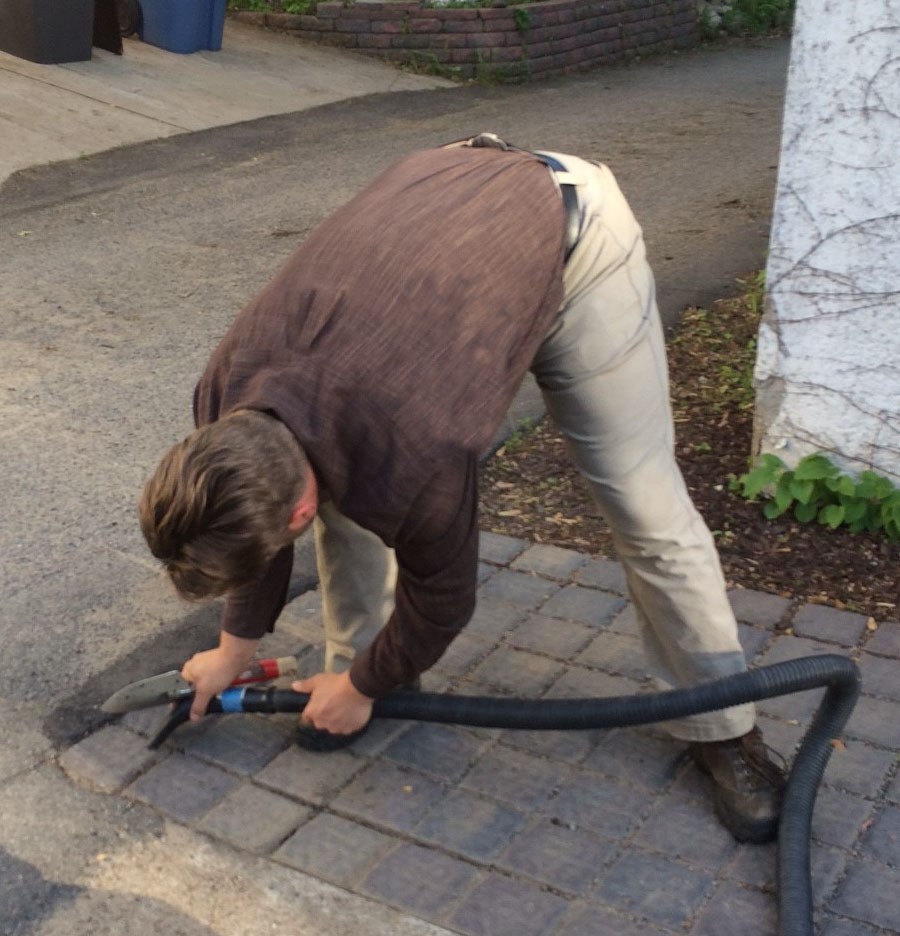You’ve got this great new permeable pavement in your driveway. Now what?
As with everything we value, some level of maintenance is required in order to keep it looking good and functioning properly. Our teeth, our cars, our relationships and yes, our permeable pavers too. But before we get into how to care for this new pavement, let’s review what they are and how they work.
Stormwater runoff from driveways that are directly connected to our alleyways often contain the highest concentration of pollutants from the urban landscape. Permeable pavement systems are design to capture, store and infiltrate stormwater into the ground, thus reducing the amount of runoff that would otherwise flow directly into the storm sewer system, carrying harmful pollutants to our local creeks, wetlands, lakes, and rivers.

Typical permeable pavement sections have 20-inches of drainage rock below the surface, acting as a reservoir to hold water while it slowly infiltrates into the sub-soils. (Check out this fun time lapse video of a Blooming Alley permeable pavement installation).
The gaps between your permeable pavers allow stormwater to drain into the reservoir before it reaches the alley. It is imperative that these gaps remain relatively free of dirt and organic material. This is where our maintenance story begins.

Steps to maintaining Permeable Pavement:
1. Preventative maintenance – Keep your pavement clean, both the permeable pavers AND the areas draining to them. Try to keep leaves, dirt and sand from accumulating on your drive. Keep adjacent landscape areas well maintained and prevent soil from being washed onto pavement. The cleaner you can keep the surface the less likely your pavers will clog resulting is less paver maintenance.

2. Inspection – Inspect your pavers directly following a rain event, at least three times a year. Look for indications of clogged pavers such as pooling water, visible dirt and organic material in the joints and weed growth. Permeable pavers will still function when they are partially clogged, but it’s best to clear the joints before they get encrusted.
Note: there may only be a small section of your pavers that are clogged and in need of maintenance
3. Remove Debris – Vacuum your pavers when clogged joints are observed (up to twice a year). Use a shop vacuum to clear out the joints, recommended 6hp or better. Consider going in on one with your neighbors and sharing the costs or renting one.
It is helpful to use a narrow object like a screwdriver or a large nail to loosen encrusted and compacted material in the joints prior to vacuuming. This process goes much faster with the help of others – have a paver cleaning party with your neighbors.
It is common to suck up the granite chips along with the dirt and grime. Granite chips can be washed and reused to fill the joints or for grit during winter months.
4. Replace Granite – Sweep granite chips back into the joints. Fill the joints ¼-inch from the top. Sweep up excess aggregate.
For additional replacement granite chips, check with your local landscape or aggregate supply store. Ask for 1/4 or 3/8 inch. If you’re unsure what size you need, check with the paver manufacturer.
Winter Maintenance
Permeable pavers are often safer than traditional pavements in the winter. They perform amazingly well in the winter as water either infiltrates in the joints or quickly evaporates from their surface after snow has been removed. When installed correctly, permeable pavers will not heave. The paver surface edges are also chamfered to prevent shovels and plows from jamming. It’s always best to remove snow from your pavers right after snow fall to prevent snow and ice buildup.
Never use sand as it will clog the joints. If you need some grit for traction, it’s best to use joint material (crushed granite) and then sweep it up in the spring. If you must use salt, use it sparingly. A very small amount goes a very long way. One reason permeable pavements help improve water quality is the fact that they require little to no salt in the winter.
For more information on proper salt application, check out this blog by the Mississippi Watershed Management Organization.
Follow these basic steps and your permeable pavement should look great and function efficiently for years and years to come.

